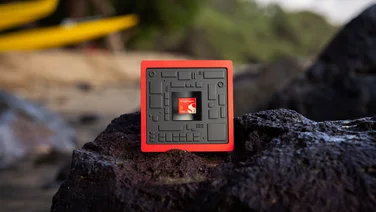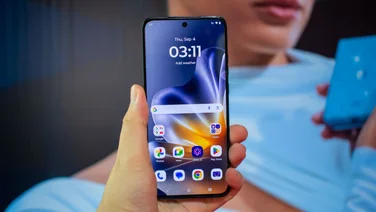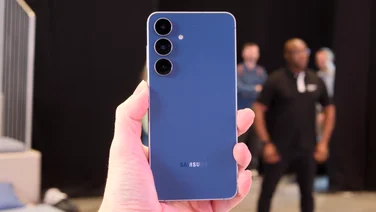To help us provide you with free impartial advice, we may earn a commission if you buy through links on our site. Learn more

Google is in the process of designing and building the world’s first modular smartphone: Project Ara will let users swap out and upgrade individual parts of their phone, rather than force them to buy a whole new handset every time a faster CPU, higher resolution screen or higher megapixel camera arrives. It’s a bold new concept, which is still a long way from becoming a reality, but with the first retail prototypes expected to arrive in 2015, we’re gathering all the information we can on the project to help you decide whether an upgradable smartphone is worth your cash.
Project Ara History
Project Ara started off under Motorola Mobility’s Advanced Technologies and Projects team, while the company was still a subsidiary of Google. It was developed out of Dave Hakkens’ original Phonebloks concept, with the company working in partnership with the Dutch designer to make his concept a reality. When Google sold the company to Lenovo, it retained Project Ara in its entirety, keeping the project team on as part of the Android division.
The team assembled to work on the project was featured in an early update video, posted to the Phonebloks YouTube channel earlier this year. As well as giving us a glimpse at prototype hardware, the video also explains some of the design decisions made by Google and details the challenges of making a modular device designed to fit in your pocket.
Developers were given the first concrete details of the platform at the first Project Ara Developer Conference in April 2014. The event was supposed to help get companies, engineers and programmers familiar with the process of designing and producing the physical parts that comprise Ara modules, so was heavy on technical detail, but if you want to dig deep within Project Ara’s innards, you can watch the entire ten hour video stream from the event on the Google ATAP YouTube channel.
We got our first glimpse at a working prototype at this year’s Google I/O developer conference in June. Although the event was primarily focused on Android Lollipop, which was announced under the code name Android L, Project Ara was given a small spot on the billing. Unfortunately the prototype failed to get past the Android boot screen, but it still provided a tantalising early look at the hardware in action.
During the demonstration, a Project Ara developer challenge was issued: Anyone creating a working module that lets Ara do something no smartphone has ever done before will earn a $100,000 prize and an all-expenses paid trip to the next Ara developer conference.
Everything went quiet after Google I/O, until late August when Google announced a deal with system-on-chip manufacturer RockChip to provide a custom-made CPU specifically for Project Ara. The proprietary chip, which will replace the Texas Instruments OMAP 4660 SoC used in current prototypes, uses a native general-purpose interface that doesn’t require a bridge chip. This simplifies the design versus the older prototypes, and will potentially reduce the overall cost of the final handset. Google expects the first Rockhip-powered handsets to be demoed in early 2015, which lines up with the company’s anticipated initial release date for the phone itself.
The latest progress video, released in October, focuses on NK Labs – the team actually building the Project Ara prototype. The video gave us our clearest look yet at the different modules, how they will clip into the handset, and how quickly it boots into Android.
There might only be seven people on the team, but NK has clearly made progress from the last prototype; it has several modules, including LEDs, batteries, processor, speaker and USB charge port, ready for testing. Now the development has switched to custom-built Toshiba chips there’s more room in each module for developers to add features, rather than working around the components needed to make the device modular. Nicknamed Spiral 2, Project Ara is clearly taking shape, and is set for a public unveiling at the Project Ara Developer Conference on the 14th of January.
Also in October, it was discovered Google had trademarked the Ara name, suggesting it will be launching the handset without the Project prefix, rather than come up with a brand new name.
Project Ara Design
When Google revealed the first details of Project Ara, it announced that the modular smartphone would be built around a metal endoskeletal frame, known as an ‘endo’ for short. This will apparently be the only component actually made by Google, with all the individual modules being produced by third-party companies. The endo will initially be available in two sizes: “mini”, which will be slightly smaller than a first generation Moto G, and “medium”, about the same size as Google’s own Nexus 5 smartphone. Further down the line, a “large” frame will be released for phablet fans – it should be roughly the same size as Samsung’s Galaxy Note 4.

Currently, Google expects the finished device to be about 10mm thick with modules installed. That’s 3-4mm thicker than most current flagship smartphones, but hardly so big that you won’t be able to slip it in a pocket.
The endo frame will have slots in the front for the display and other modules, with extra slots on the back for yet more modules. It’s the modules that will add a splash of colour and personalisation to each Project Ara device, with Google working with 3D printing companies to customise each module enclosure. Customers will be able to design their own enclosures, and replace them with new designs as and when they like using the Ara Configurator app. Colours, patterns and images can be uploaded, tweaked and adjusted until you’re happy, then ordered directly through the app.

Project Ara Modules
Project Ara is built around the concept of modular design. Each component will be housed in a separate module, letting you swap them out as and when you choose. If you want a seriously powerful handset, you could stick in the fastest processor you can afford, but if you prize battery life over performance you could swap it for a slower chip – or dump the rear camera for a bigger battery. As well as common smartphone features, Google expects Ara modules to provide more specialised features for specific customers. Pico projectors, night vision sensors, game controller buttons and medical devices have all been suggested, although Google itself won’t be making any of them a reality.
Modules on the front of an Ara handset can be of various heights, but take up the whole width of the frame. On the back, modules can be either 1×1, 1×2 or 2×2, letting you organise them to your own personal preference. They will all be held in place on the endo frame using electropermanent magnets, so you won’t have to worry about them falling off in a pocket or purse. Google is aiming to make it possible to hot-swap modules, letting you switch out components without having to power off the phone first, and plans to fit a small backup battery to the frame so you can even hot-swap the main battery module.
According to Ara team leader Paul Eremenko, Google will open a special online store for Ara components, which will include user reviews and recommendations. Because the module development kit is free, open-source and available to all, anyone could create a module and sell it through the store directly to customers. Modules sold through Google’s store will be ‘official’, and although it will be possible to buy modules from third-party sources, these will be ‘unofficial’. You’ll apparently have to enable a setting to use unofficial modules, much like how you have to enable third-party app installs on an Android smartphone today.

To date, few big-name manufacturers have openly committed to Project Ara. Headphone specialist Sennheiser is the exception; it pledged to contribute its audio expertise to the original Phonebloks concept as far back as May – a pledge that it will honour now Google has picked up the reins. According to Dave Hakkens, “Sennheiser has the necessary technical excellence and also shares a corporate philosophy that places equal emphasis on sustainability.
“Its products are distinguished by first-class quality and durability and they also provide the option of replacing individual components. This sustainability ethos is an essential part of our company vision.”
Sennheiser has said it will help perfect the technology’s speech function and audio transmission, but has yet to go into further details or reveal any hardware prototypes. Although it’s possible the company won’t actually produce speakers or microphone modules, focusing instead on the underlying technology, it seems likely Sennheiser-branded Ara modules will appear at some point in the future.
Project Ara release date
There are still plenty of technical hurdles to overcome before Project Ara becomes a reality, but Google is confident it can manage it sooner rather than later; it confirmed at the Google I/O conference that the first Ara Endo handsets should be going on sale in January 2015. It appears as though the small and medium sized Endo frames will be first to launch, with the large frame to follow at a later date.
As with Google’s previous concept products, including the Google Glass headset, it’s highly likely that Ara will be limited to the US at launch, with international availability to follow later.

Project Ara price
Although nothing has been confirmed yet, Google has hinted that a Project Ara endo frame could cost as little as $15 to produce. However, you’ll have to add in the cost of a screen, processor, storage and communication modules at the very least before you’ll be able to put a working phone together. According to a New York Times article, a basic functioning Ara handset could cost no more than $50 to make, although this won’t include any cellular connectivity – just Wi-Fi. Google will probably want to make a profit, too, so expect final retail prices to be higher.
It’s unclear whether other modules will be available at launch, or whether the first devices will launch by themselves. Either way, it’s unlikely you’ll be able to build a flagship-beating Ara handset before the summer. Modules will start appearing after developers actually get their hands on Ara hardware, and technical challenges associated with bridge chips and compatibility could mean users are limited in terms of performance or features – at least at first.
We’ll be updating this article with more information as we get closer to launch, so be sure to check back regularly for any new developments.





